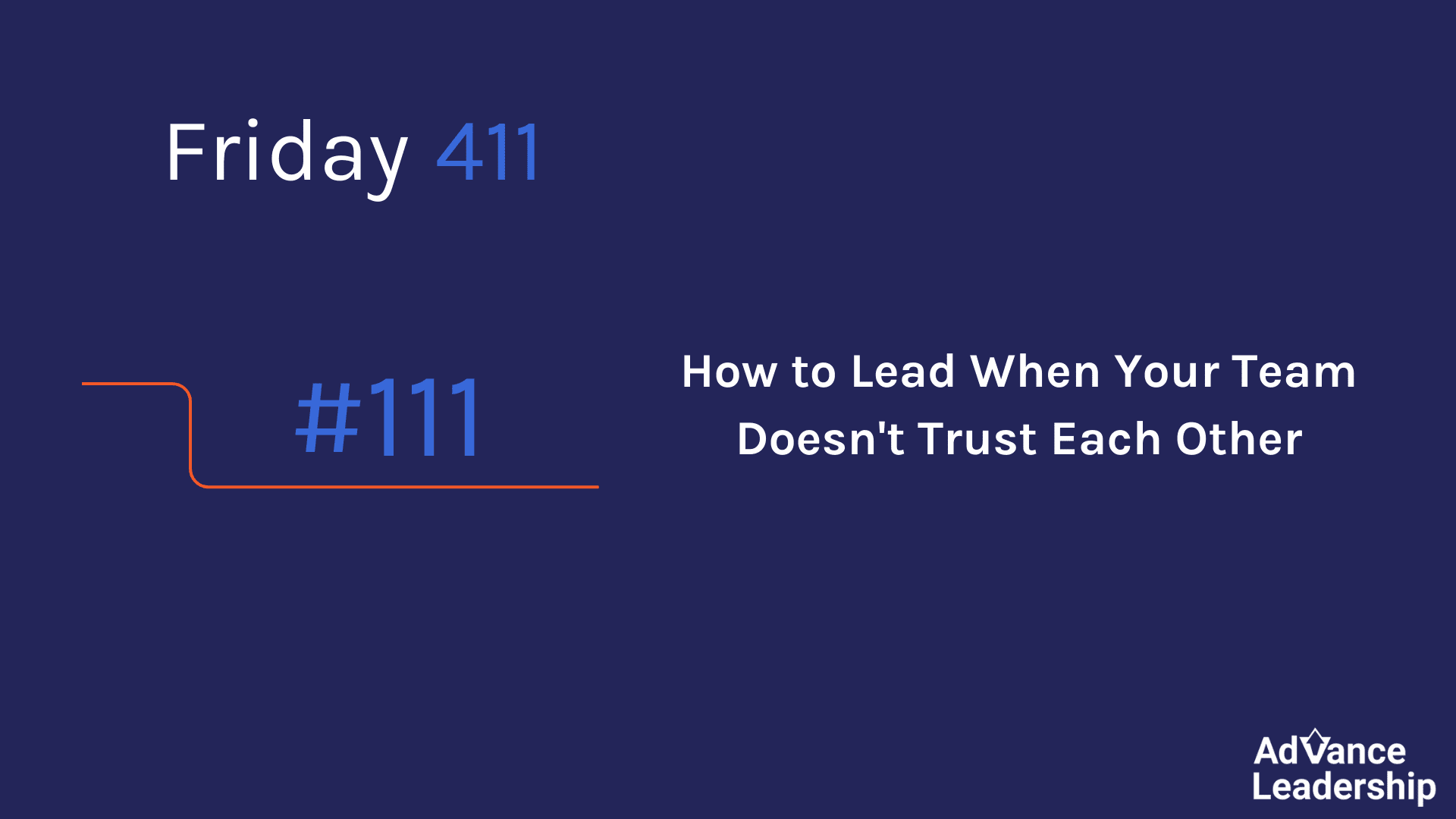🚀 BOOK LAUNCH UPDATE 🚀
Our next book debuts later this year.
This week, we finalized the title!
Unleashed Leadership: How to Solve the 7 Issues
Holding You Back from Your Greatest Impact
We can’t wait to share this with you.
Welcome to Friday 411, issue #111. In 4 minutes, with 1 insight and 1 action, you’ll build a team who trusts you and each other.
1 Insight
If you want a high-performing team, you can’t stop at building trust with your team—you must build trust within your team, too.
Why Teams Break Down: Sarah’s Challenge
We recently worked with a leader named Sarah who managed ten people. She had built strong trust with each of them individually. They openly shared challenges and successes with her.
But Sarah noticed her team acted differently with each other than they did with her. Even though they all needed to collaborate on several projects, people guarded their information, chose their words carefully, and often seemed disinterested and disengaged during team meetings.
While Sarah experienced strong trust with each person on the team, she had not generated a trusting environment. She needed to continue building trust with each person and create space for her team to trust each other.
When you encounter a similar challenge in your team, deal with it quickly. When team members don’t trust each other, they waste energy, avoid hard conversations, and hold back their best work. Harvard Business Review found that when leaders intentionally build connection, trust and performance both skyrocket.
How can you, the leader, facilitate trust among your team? Start by realizing that trust is multidimensional.
The Three Types of Trust
To build trust within your team, you need to understand:
(1) the three types of trust;
(2) signs of low trust; and
(3) how you can help.
1. Relational Trust
This is trust built through personal connection. It happens when team members see each other as humans, not just roles.
Signs of Low Relational Trust:
-
- People don’t know each other’s stories.
- They avoid chit-chat or never ask personal questions.
- There’s no warmth in meetings.
How You Can Help:
-
- Host a “Get to Know You” team meeting with non-invasive questions:
- What’s your favorite food?
- Who’s someone who changed your life?
- What was your first job?
- Host a “Get to Know You” team meeting with non-invasive questions:
These questions help people make connections with each other and open space for deeper questions.
-
- Start meetings with time for connecting. Ask people to share a highlight from the weekend or give updates about their lives.
- Set the tone by sharing first. When leaders open up, others follow.
2. Integrity Trust
When your team has confidence in each other’s character, they develop Integrity Trust. It’s rooted in the belief that the other person has good intentions and is honest and kind in their dealings with others.
Signs of Low Integrity Trust:
-
- People assume negative motives of each other.
- People demonstrate passive-aggressive behaviors.
- Team members talk negatively about other team members.
How You Can Help:
-
- Foster a community of collaboration over competition. Avoid motivational strategies that pit workers against one another, promoting fear, suspicion, or paranoia. Instead, encourage winning as a team.
- Define Team Operating Principles. Clarify how you handle disagreements and how your team speaks to and about each other.
- When disrespect happens, address it quickly, privately, and respectfully and coach both parties forward.
- Assume positive motives when people make mistakes, and help your team do the same.
3. Skill Trust
This is trust built through seeing another person’s competencies. It’s confidence in someone’s ability to do their job well.
Signs of Low Skill Trust:
-
- Second-guessing each other’s work.
- Reluctance to collaborate or delegate.
- Complaints about “picking up slack.”
How You Can Help:
-
- Run a team-skills audit. Have team members share their skills and how others on the team can better collaborate with them.
- Use CliftonStrengths to familiarize your team with each other’s talents. Engagement increases 6x when people use their strengths. (If you’d like to learn more about using CliftonStrengths for team-building, contact us.)
- Allow peers to teach their expertise to the group—even short 5-minute skill-shares.
- Normalize asking for help. Model this yourself: “Hey, you’re great at this—can you teach me how you do it?”
A Leader’s Job: Build Community
There are only seven leadership issues that cause 95% of the problems you face: Character, Competence, Capacity, Clarity, Community, Culture, and Consistency. Sarah got to the root cause of her problem—Community.
If your team struggles to connect and collaborate, you have a Community problem, too. Community is about creating a trust-filled, mission-focused connection that helps your team thrive.
Strong teams aren’t built by accident—they’re built by leaders who are intentional about trust.
1 Action
Pick one type of trust your team struggles with most. Talk about it with your team, then start practicing it.
Want help building trust across your team or company? Let’s talk.
We offer leadership experiences that help solve the problems low-trust (and even high-trust) teams experience.

